 In its latest Commodity Special Feature (pages 43 to 53 of the October 2020 World Economic Outlook), the IMF examines the future of oil and other commodity prices. With the collapse in oil demand during the early stages of the coronavirus pandemic, oil prices plummeted. Brent crude fell from around $60 per barrel in late January to below $20 in April.
In its latest Commodity Special Feature (pages 43 to 53 of the October 2020 World Economic Outlook), the IMF examines the future of oil and other commodity prices. With the collapse in oil demand during the early stages of the coronavirus pandemic, oil prices plummeted. Brent crude fell from around $60 per barrel in late January to below $20 in April.
However, oil prices then rose somewhat and have typically been between $40 and $45 per barrel since June 2020 – still more than 35% lower than at the beginning of the year (see chart below: click here for a PowerPoint). This rise was caused by a slight recovery in demand but largely by supply reductions. These were the result partly of limits agreed by OPEC+ (OPEC, Russia and some other non-OPEC oil producing countries) and partly of reduced drilling in the USA and the closure of many shale oil wells which the lower prices had made unprofitable.
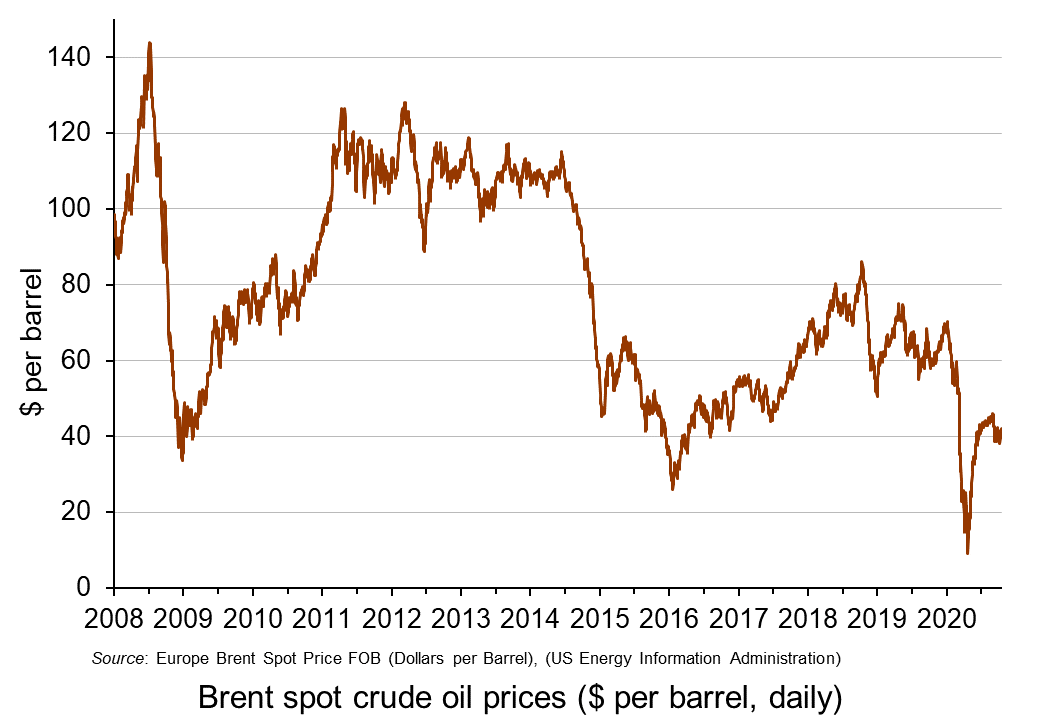 The IMF considers the future for oil prices and concludes that prices will remain subdued. It forecasts that petroleum spot prices will average $47 per barrel in 2021, up only slightly from the $42 average it predicts for 2020.
The IMF considers the future for oil prices and concludes that prices will remain subdued. It forecasts that petroleum spot prices will average $47 per barrel in 2021, up only slightly from the $42 average it predicts for 2020.
On the supply side it predicts that ‘stronger oil production growth in several non-OPEC+ countries, a faster normalization of Libya’s oil production, and a breakdown of the OPEC+ agreement’ will push up supply and push down prices. Even if the OPEC+ agreement holds, the members are set to ease their production cut by nearly 25% at the start of 2021. This rise in supply will be offset to some extent by possibly ‘excessive cuts in oil and gas upstream investments and further bankruptcies in the energy sector’.
On the demand side, the speed of the recovery from the pandemic will be a major determinant. If the second wave is long-lasting and deep, with a vaccine available to all still some way off, oil demand could remain subdued for many months. This will be compounded by the accelerating shift to renewable energy and electric vehicles and by government policies to reduce CO2 emissions.
Report
Articles
Oil price data
Questions
- Describe a scenario in which oil prices rebound significantly over the coming months. Illustrate your answer with a supply and demand diagram.
- Describe a scenario in which oil prices fall over the coming months. Again, illustrate your answer with a supply and demand diagram.
- How are the price elasticities of demand and supply relevant to the size of any oil price change?
- Project forward 10 years and predict whether oil prices will be higher or lower than now. What are the major determinants of supply and demand in your prediction?
- What are oil futures? What determines oil future prices?
- How does speculation affect oil prices?
 For the majority of people, a house (or flat) is the most valuable thing they will ever own.
For the majority of people, a house (or flat) is the most valuable thing they will ever own.
It is important to understand the role that house prices play in the economy and how much of an impact they have.
The Bank of England monitors changes in the housing market to assess the risks to the financial system and the wider economy. The housing market employs large numbers of people in construction, sales, furniture and fittings, and accounts for a sizeable percentage of the value of GDP. The market is closely linked to consumer spending and therefore is a crucially important sector of the economy.
The concepts of supply and demand can be applied to understand house price changes and the impacts on the economy.
What is the housing market?
The housing market brings together different stakeholders, such as homeowners who are selling their properties, people seeking to buy a property, renters, investors who buy and sell properties solely for investment purposes, contractors, renovators and estate agents, who act as facilitators in the process of buying or selling a property.
In the UK, two-thirds of households own the property in which they live, and the remaining third of households are renters, split fairly equally between private and social renting. We can thus divide people into:
- Homeowners – either outright owners or with a mortgage;
- Private renters – people renting from private landlords;
- Social renters – people renting from local authorities and housing associations.
There are many determinants of demand and supply in the housing market, many of which are related to demographic factors. Such factors include the size of the market, rate of marriages, divorces, and deaths. However, factors such as income, availability of credit, interest rates and consumer preferences are also important.
Why is the housing market important for the economy?
 Changes in the housing market are always given such importance due to the relationship house prices have with consumer spending. Changes in house prices and the number of sales affect how much money people have to spend. Given that household spending accounts for two-thirds of Britain’s total economic activity, any changes in consumption is likely to have a major impact on the wider economy. Observing the housing market helps us to assess the overall demand for goods and services.
Changes in the housing market are always given such importance due to the relationship house prices have with consumer spending. Changes in house prices and the number of sales affect how much money people have to spend. Given that household spending accounts for two-thirds of Britain’s total economic activity, any changes in consumption is likely to have a major impact on the wider economy. Observing the housing market helps us to assess the overall demand for goods and services.
When house prices increase, those consumers who own their own homes have now become better off as their houses are worth more. This ‘wealth effect’ increases the confidence of homeowners, which in turn increases consumption. Some of these homeowners will decide to acquire additional borrowing against the value of their home. The borrowing is then spent in the economy on goods and services, thereby increasing aggregate demand and GDP.
However, when house prices decline, homeowners lose confidence as their home is now worth less than before. This becomes a major issue if prices have decreased enough to make their house worth less than the remainder of the unpaid mortgage – known as ‘negative equity’. Homeowners will therefore reduce their consumption and will be less likely to undertake any new borrowing.
The vast majority of homeowners will have taken out a mortgage in order to purchase their home. Mortgages are the largest source of debt for households in the UK. More than 70% of household borrowing is mortgage debt. Half of all homeowners who live in the house they own are still paying off their mortgage. Therefore, households might suddenly hold back on their spending during times of uncertainty because they start to worry about repaying their debts. This has a knock-on effect on the rest of economy, and a small problem can suddenly become a big one.
In addition to affecting overall household spending, the buying and selling of houses also affects the economy directly. Housing investment is a small but unpredictable part of total output in the economy. There are two different ways in which the buying and selling of houses impacts GDP.
 The first is when a new build is purchased. This directly contributes to GDP through the investment in the land to build the house on, the purchase of materials and the creation of jobs. Once the homeowners move in they also contribute to the local economy: i.e. shopping at local shops.
The first is when a new build is purchased. This directly contributes to GDP through the investment in the land to build the house on, the purchase of materials and the creation of jobs. Once the homeowners move in they also contribute to the local economy: i.e. shopping at local shops.
The second is when an existing home is bought or sold. The purchase of an existing home does not have the same impact on GDP. However, it does still contribute to GDP: i.e. from estate agents’ and solicitors’ fees and removal costs to the purchase of new furniture.
Why house prices change: demand and supply
Demand: the demand for housing can be defined as the quantity of properties that homebuyers are willing and able to buy at a given price in a given time period. Factors affecting the demand for housing include:
- Real incomes: If real incomes increase the demand for housing increases due to a rise in the standard of living.
- The cost of a mortgage: If there is a rise in interest rates in the economy, mortgage interest rates are likely to rise too. This makes the cost of financing a loan more expensive and therefore will see a decline in demand.
- Availability of credit: The more lending banks and building societies are willing to provide, the more people will borrow and spend on housing and hence the higher house prices will be.
- Economic growth: When the economy is in the recovery and boom stages of the business cycle, wages rise. This will increase the demand for houses.
- Population: When the population increases or if there is an increase in single-person households, demand for housing increases.
- Employment/unemployment: The higher the level of unemployment in an economy, the less people will able to afford housing.
- Confidence: If consumers feel optimistic about the future state of the economy, they will be more likely to go ahead with purchasing a house, thereby increasing demand. House prices tend to rise if people expect to be richer in the future.
Supply: The supply of housing can be defined as the flow of properties available at a given price in a given time period. The supply of housing includes both new-build homes and existing properties. Factors affecting the supply for housing include:
- Costs of production: The higher the cost of production, the fewer houses are built, reducing the supply of housese coming to the market. Example of costs include: labour costs, land for development and building materials.
- Government policy: If the government increases taxation and/or reduces subsidies for new house developments, there will be fewer new houses built.
- Number of construction companies: Depending on their objectives, the more construction companies there are, the more likely there is to be an increase in the supply of housing. The construction industry accounts for around 7% of UK GDP.
- Technology and innovation: With improved technology and innovation in the construction industry, houses become cheaper and easier to build, thus increasing the supply.
- Government spending on building new social housing: The government has the ability to influence the supply of housing by increasing spending on new social housing.
Price elasticity of supply
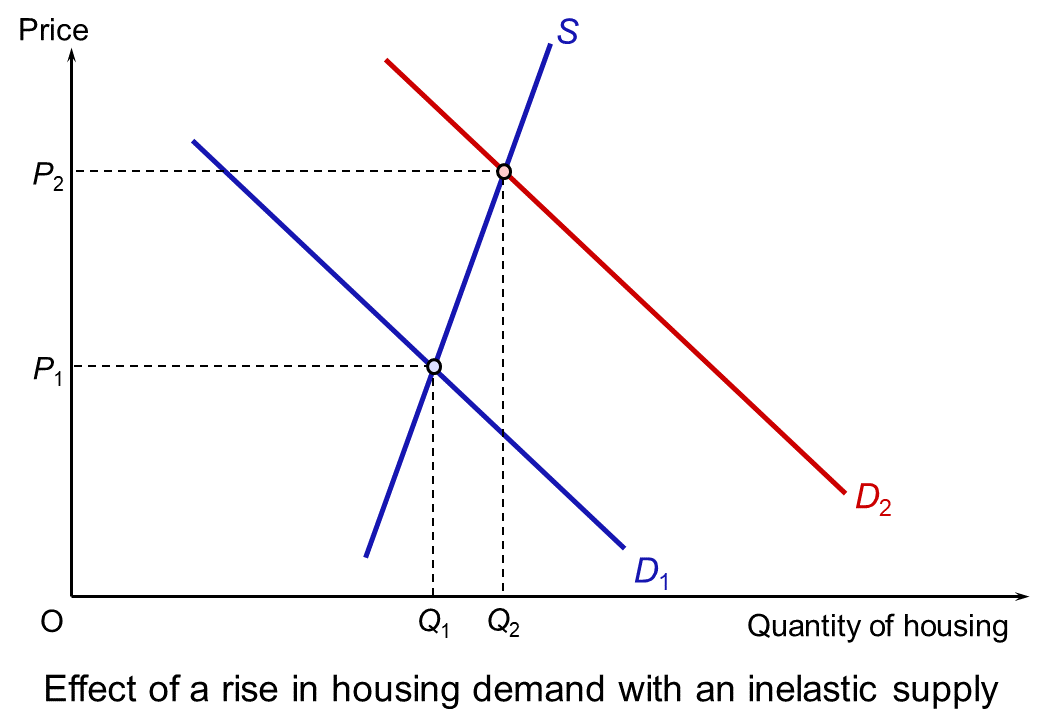 The supply of new housing in the short run is price inelastic. The main reason for this is the time it takes to build a new home. The production of a house can take many months, from the planning process to the project’s completion. Supply also relies on access to a skilled labour force and the availability of certain construction materials.
The supply of new housing in the short run is price inelastic. The main reason for this is the time it takes to build a new home. The production of a house can take many months, from the planning process to the project’s completion. Supply also relies on access to a skilled labour force and the availability of certain construction materials.
Because of the inelastic supply, any changes in demand are likely to have a significant effect on price. This is illustrated by the diagram, which shows a larger proportionate increase in price than quantity when demand increases from D1 to D2.
The current UK housing market
Despite the current economic climate and the effects of the lockdown restrictions on consumers, house prices have increased, and sales have now resumed. Rightmove, which advertises 95% of homes for sale, states that the housing market has seen its busiest month in more than 10 years in July. During the summer, the housing market usually sees a lull in activity. However, since the easing of lockdown, there has been a flurry of activity from buyers and sellers. Since July 2019, house prices have increased by 1.7%, according to the Nationwide Building Society.
 London estate agency, Hamptons, states that homeowners are now bringing forward their moving plans as the experience of lockdown has encouraged them to seek more space. The mortgage market is also very favourable right now in terms of interest rates, and rental demand is continuing to surge across the UK.
London estate agency, Hamptons, states that homeowners are now bringing forward their moving plans as the experience of lockdown has encouraged them to seek more space. The mortgage market is also very favourable right now in terms of interest rates, and rental demand is continuing to surge across the UK.
The increase in activity in the market has also been helped by the announcement of a stamp duty ‘holiday’ until March 2021. This sees the threshold above which stamp duty is paid rising from £125 000 to £500 000. Estate agency, Savills, has also seen an increase in the number of new buyers registering with its service, more than double the number registered in July 2019. It is thought that, along with the tax savings from stamp duty, people’s experiences in lockdown have made them evaluate their current living space and reconsider their housing needs.
However, given the that the economy is experiencing its deepest recession on record, there is concern about just how long the market can resist the economic forces pulling prices down.
Historically, a drop in house prices has been both a cause and a consequence of economic recessions. During the 2008 financial crisis, house prices fell by about 30%. As previously mentioned, for the majority of people, a house is the most valuable thing they will ever own and therefore consumers are extremely interested in its value. Consumer confidence is one of the key factors affecting the demand for housing. If consumers feel pessimistic about the future state of the economy, they will be less likely to go ahead with purchasing a house, thereby decreasing demand. Britain’s Office for Budget Responsibility, the country’s fiscal watchdog, forecasts that during this downturn prices will fall 5% this year and 11% in 2021.
Various government schemes put in place to help during lockdown are starting to come to an end. The main one – the furlough scheme, which replaced 80% of eligible workers’ incomes – comes to an end in October. It is forecast that labour market conditions will weaken significantly in the quarters ahead, with unemployment predicted to rise for the rest of the year. If these predictions materialise, it would likely dampen housing activity once again.
Conclusion
Fluctuations in house prices and transactions tend to amplify the volatility of the economic cycle. Therefore, it is crucial that we understand what influences such changes. Understanding how supply and demand factors influence the housing market can enable key stakeholders to make better predictions about future activity and plan accordingly. The current market has seen a growth since the easing of restrictions but there is concern that this has been powered by pent-up demand. Therefore, the outlook for house prices is uncertain and the full effects of an economic downturn are yet to be realised.
Articles
Questions
- Explain why the supply of housing is inelastic in the short-term.
- Given that the elasticity of housing supply in the UK is low, what policies could be introduced to ensure that house building is more responsive to changes in market demand?
- If unemployment does increase as predicted, explain what impact this would have on the demand in the housing market and house prices? Use a supply and demand diagram to aid your answer.
- Explain how changes in house prices affect the government’s key macroeconomic objectives.
 Share prices are determined by demand and supply. The same applies to stock market indices, such as the FTSE 100 and FTSE 250 in the UK and the Dow Jones Industrial Average and the S&P 500 in the USA. After all, the indices are the weighted average prices of the shares included in the index. Generally, when economies are performing well, or are expected to do so, share prices will rise. They are likely to fall in a recession or if a recession is anticipated. A main reason for this is that the dividends paid on shares will reflect the profitability of firms, which tends to rise in times of a buoyant economy.
Share prices are determined by demand and supply. The same applies to stock market indices, such as the FTSE 100 and FTSE 250 in the UK and the Dow Jones Industrial Average and the S&P 500 in the USA. After all, the indices are the weighted average prices of the shares included in the index. Generally, when economies are performing well, or are expected to do so, share prices will rise. They are likely to fall in a recession or if a recession is anticipated. A main reason for this is that the dividends paid on shares will reflect the profitability of firms, which tends to rise in times of a buoyant economy.
When it first became clear that Covid-19 would become a pandemic and as countries began locking down, so stock markets plummeted. People anticipated that many businesses would fail and that the likely recession would cause profits of many other surviving firms to decline rapidly. People sold shares.
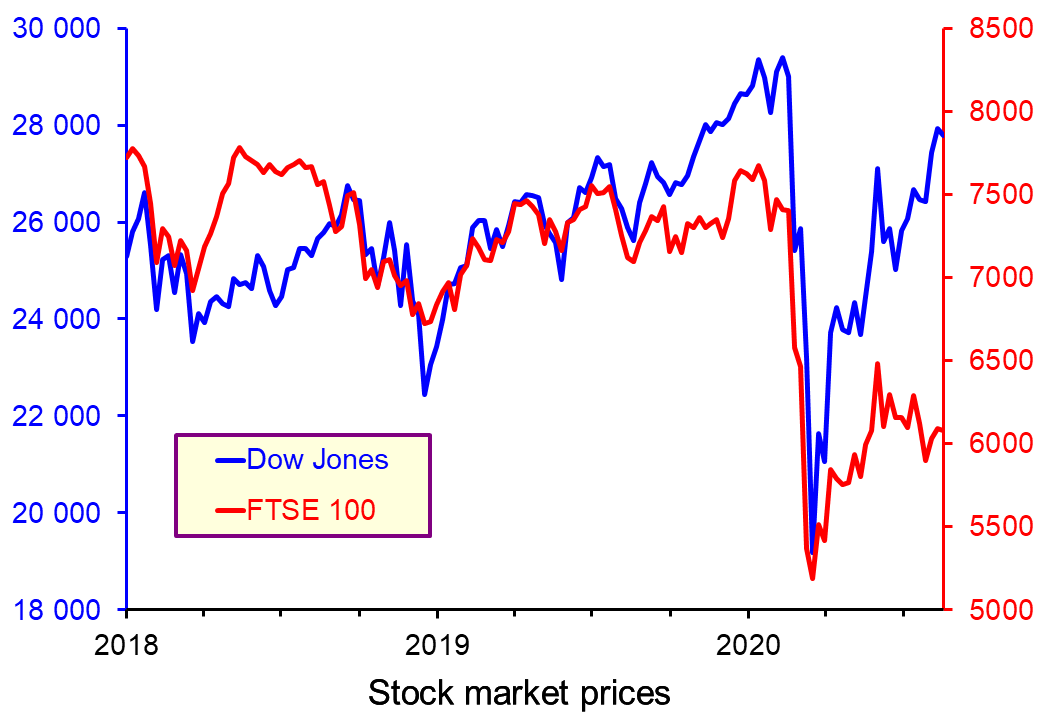 The first chart shows how the FTSE 100 fell from 7466 in early February 2020 to 5190 in late March, a fall of 30.5%. The Dow Jones fell by 34% over the same period. In both cases the fall was driven not only by the decline in the respective economy over the period, but by speculation that further declines were to come (click here for a PowerPoint of the chart).
The first chart shows how the FTSE 100 fell from 7466 in early February 2020 to 5190 in late March, a fall of 30.5%. The Dow Jones fell by 34% over the same period. In both cases the fall was driven not only by the decline in the respective economy over the period, but by speculation that further declines were to come (click here for a PowerPoint of the chart).
But then stock markets started rising again, especially the Dow Jones, despite the fact that the recessions in the UK, the USA and other countries were gathering pace. In the second quarter of 2020, the Dow Jones rose by 23% and yet the US economy declined by 33% – the biggest quarterly decline on record. How could this be explained by supply and demand?
Quantitative easing
In order to boost aggregate demand and reduce the size of the recession, central banks around the world engaged in large-scale quantitative easing. 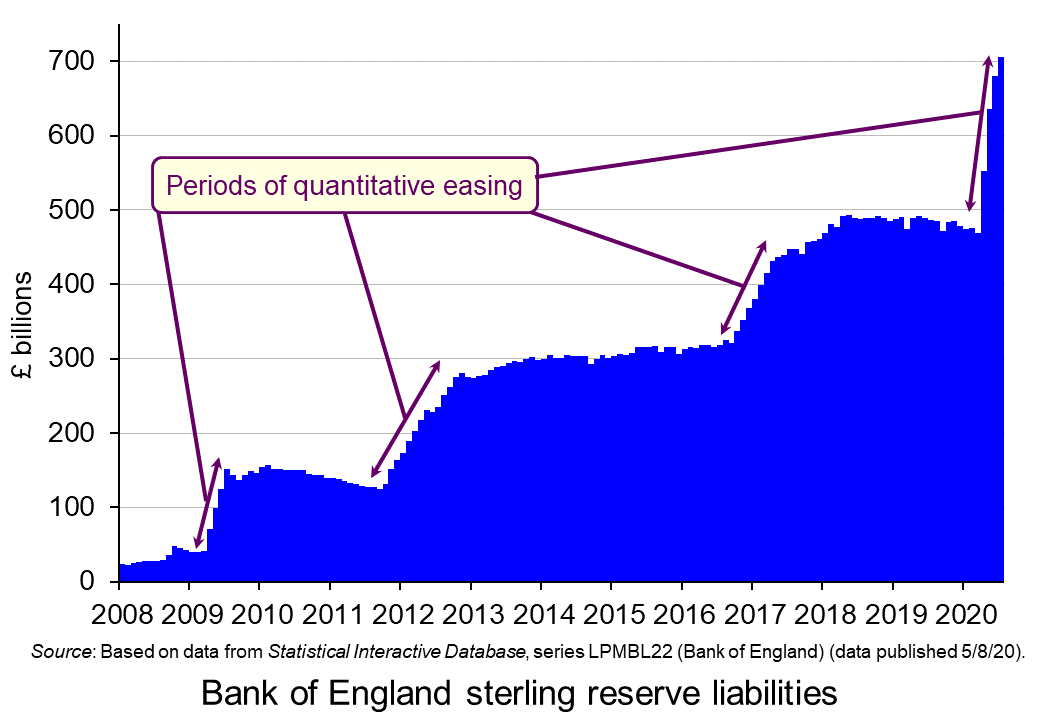 This involves central banks buying government bonds and possibly corporate bonds too with newly created money. The extra money is then used to purchase other assets, such as stocks and shares and property, or physical capital or goods and services. The second chart shows that quantitative easing by the Bank of England increased the Bank’s asset holding from April to July 2020 by 50%, from £469bn to £705bn (click here for a PowerPoint of the chart).
This involves central banks buying government bonds and possibly corporate bonds too with newly created money. The extra money is then used to purchase other assets, such as stocks and shares and property, or physical capital or goods and services. The second chart shows that quantitative easing by the Bank of England increased the Bank’s asset holding from April to July 2020 by 50%, from £469bn to £705bn (click here for a PowerPoint of the chart).
But given the general pessimism about the state of the global economy, employment and personal finances, there was little feed-through into consumption and investment. Instead, most of the extra money was used to buy assets. This gave a huge boost to stock markets. Stock market movements were thus out of line with movements in GDP.
Confidence
Stock market prices do not just reflect the current economic and financial situation, but also what people anticipate the situation to be in the future. 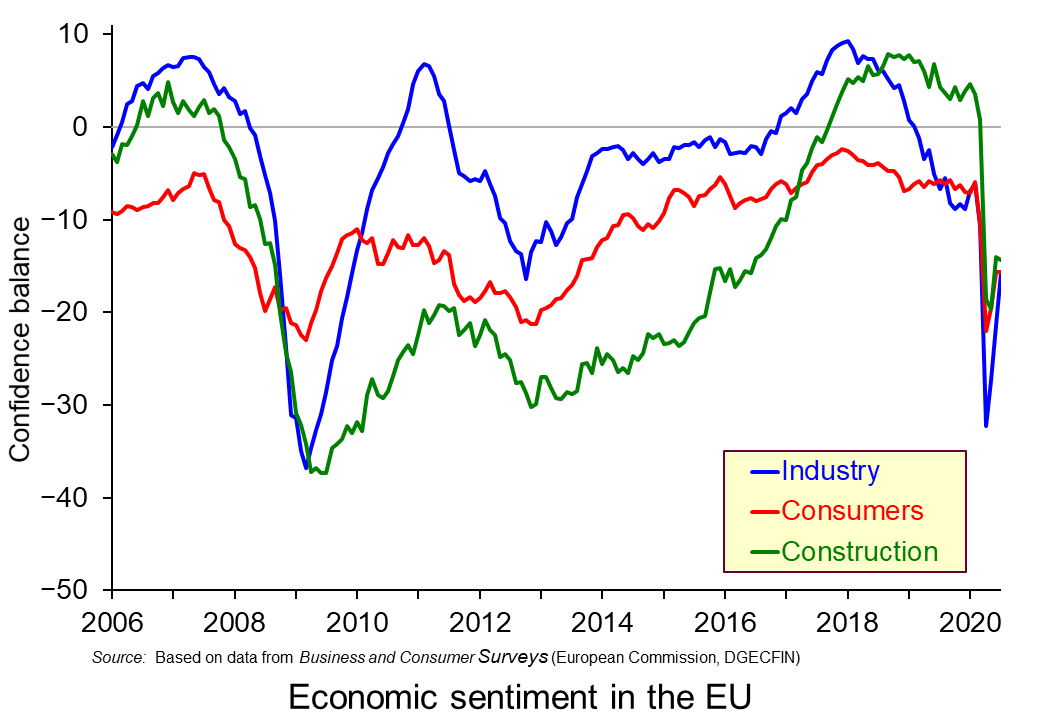 As infection and death rates from Covid-19 waned around Europe and in many other countries, so consumer and business confidence rose. This is illustrated in the third chart, which shows industrial, consumer and construction confidence indicators in the EU. As you can see, after falling sharply as the pandemic took hold in early 2020 and countries were locked down, confidence then rose (click here for a PowerPoint of the chart).
As infection and death rates from Covid-19 waned around Europe and in many other countries, so consumer and business confidence rose. This is illustrated in the third chart, which shows industrial, consumer and construction confidence indicators in the EU. As you can see, after falling sharply as the pandemic took hold in early 2020 and countries were locked down, confidence then rose (click here for a PowerPoint of the chart).
But, as infection rates have risen somewhat in many countries and continue to soar in the USA, Brazil, India and some other countries, this confidence may well start to fall again and this could impact on stock markets.
Speculation
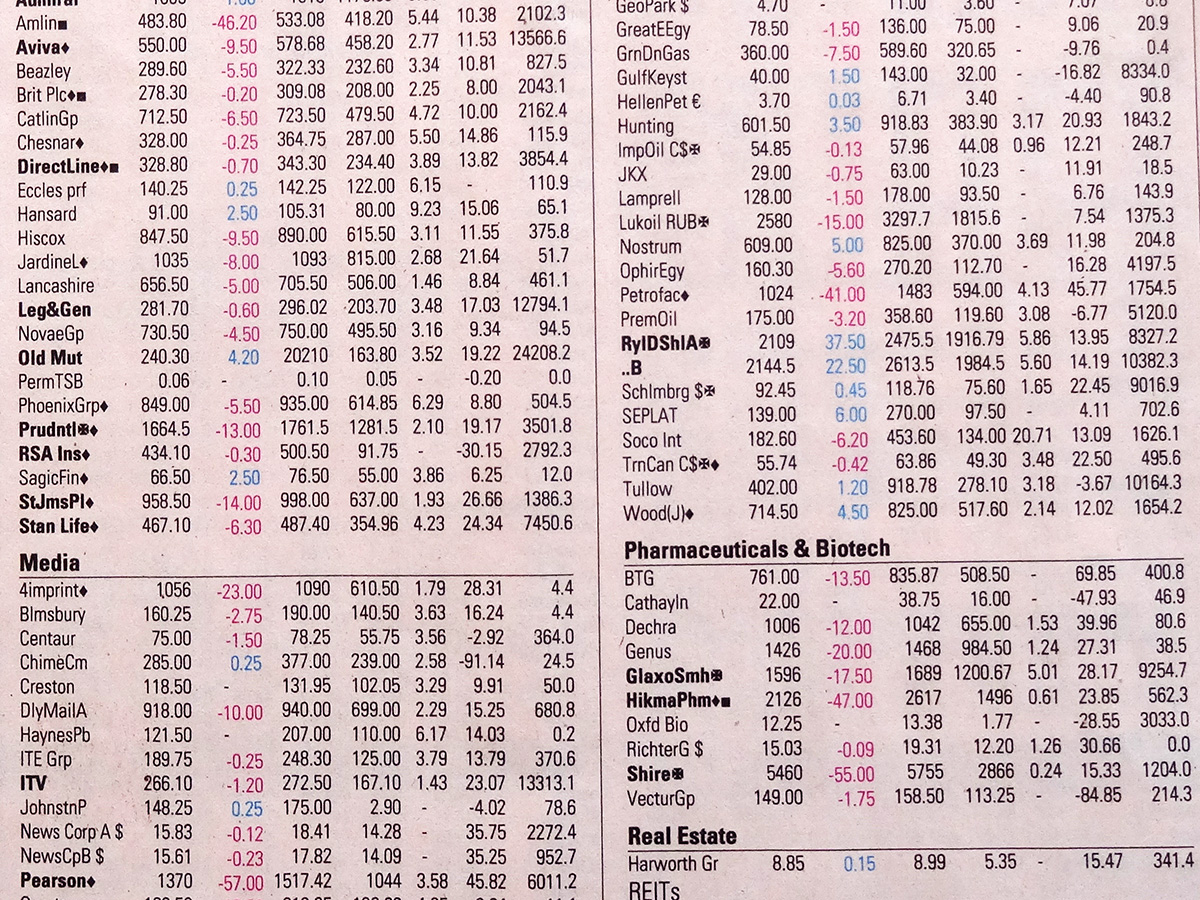 A final, but related, cause of recent stock market movements is speculation. If people see share prices falling and believe that they are likely to fall further, then they will sell shares and hold cash or safer assets instead. This will amplify the fall and encourage further speculation. If, however, they see share prices rising and believe that they will continue to do so, they are likely to want to buy shares, hoping to make a gain by buying them relatively cheaply. This will amplify the rise and, again, encourage further speculation.
A final, but related, cause of recent stock market movements is speculation. If people see share prices falling and believe that they are likely to fall further, then they will sell shares and hold cash or safer assets instead. This will amplify the fall and encourage further speculation. If, however, they see share prices rising and believe that they will continue to do so, they are likely to want to buy shares, hoping to make a gain by buying them relatively cheaply. This will amplify the rise and, again, encourage further speculation.
If there is a second wave of the pandemic, then stock markets could well fall again, as they could if speculators think that share prices have overshot the levels that reflect the economic and financial situation. But then there may be even further quantitative easing.
There are many uncertainties, both with the pandemic and with governments’ policy responses. These make forecasting stock market movements very difficult. Large gains or large losses could await people speculating on what will happen to share prices.
Articles
Questions
- Illustrate the recent movements of stock markets using demand and supply diagrams. Explain your diagrams.
- What determines the price elasticity of demand for shares?
- Distinguish between stabilising and destabilising speculation. How are the concepts relevant to the recent history of stock market movements?
- Explain how quantitative easing works to increase (a) asset prices; (b) aggregate demand.
- What is the difference between quantitative easing as currently conducted by central banks and ‘helicopter money‘?
- Give some examples of companies whose share prices have risen strongly since March 2020. Explain why these particular shares have done so well.
 With promises by the newly elected Conservative government to increase investment expenditure on health, education, innovation and infrastructure, it was expected that Rishi Sunak’s first Budget would be strongly expansionary. In fact, it turned out to be two Budgets in one – both giving a massive fiscal boost.
With promises by the newly elected Conservative government to increase investment expenditure on health, education, innovation and infrastructure, it was expected that Rishi Sunak’s first Budget would be strongly expansionary. In fact, it turned out to be two Budgets in one – both giving a massive fiscal boost.
An emergency Budget
The first part of the Budget was a short-term emergency response to the explosive spread of the coronavirus. An extra £12 billion is to be spent on the NHS and other public services. Whether this will be anything like enough to cope with the effects of the pandemic as businesses fail and people lose their jobs remains to be seen. (See the blog A global supply-side shock: the impact of the coronavirus (COVID-19) outbreak.)
A key issue is just how quickly the money can be spent. How quickly can you train health professionals or produce more ventilators or provide extra hospital beds?
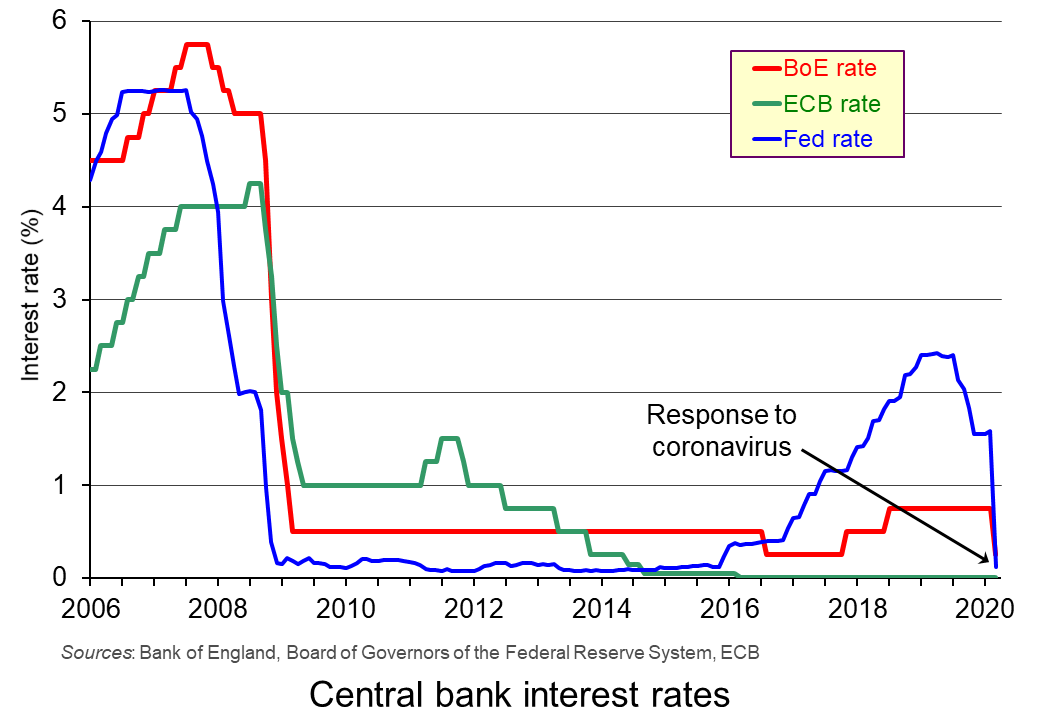 This emergency part of the Budget was co-ordinated with the Bank of England’s decision to cut Bank Rate from 0.75% to 0.25%.
This emergency part of the Budget was co-ordinated with the Bank of England’s decision to cut Bank Rate from 0.75% to 0.25%.
This combined fiscal and monetary response to the crisis was further enhanced by the agreement of central banks on 15 March to boost world liquidity by increasing the supply of US dollars through large-scale quantitative easing. The US central bank, the Federal Reserve, also cut its main federal funds rate by one percentage point from 1–1.25% to 0–0.25%.
The planned Budget
 The second part of the Budget is to raise government investment by 9% in real terms over the next four years, bringing overall government expenditure to 41% of GDP, financed largely by extra borrowing. As the IFS observes, “That is above its pre-crisis level and bigger than at any point between the mid 1980s and the start of the financial crisis.”
The second part of the Budget is to raise government investment by 9% in real terms over the next four years, bringing overall government expenditure to 41% of GDP, financed largely by extra borrowing. As the IFS observes, “That is above its pre-crisis level and bigger than at any point between the mid 1980s and the start of the financial crisis.”
But despite this rise in the proportion of government spending to GDP, in other respects the spending plans are less expansionary than they may appear. Increases in current spending on health, education and defence had already been promised. This leaves other departments, such as social security, facing cuts, or at least no increase. And when compared with 2010/11 levels, if you exclude health, government current spending per head of the population will around 14% lower, or 19% lower once you account for spending that replaces EU funding.
The Chancellor’s hope is that, by focusing on investment, there will be a supply-side effect as well as a demand-side boost. If increases in aggregate demand are balanced by increases in aggregate supply, such a policy would not be inflationary in the long run. But in the light of the considerable uncertainty of the effects of the coronavirus, the plans may well require significant adjustment in the Autumn Budget – or earlier.
Articles
Podcasts and Videos
Official documentation
Questions
- To what extent is this Budget ‘Keynesian’?
- Is the extra government expenditure likely to crowd out private expenditure? Explain.
- Demonstrate the desired long-term economic effect of the infrastructure policy using either an AD/AS diagram or a DAD/DAS diagram.
- How is the coronavirus pandemic likely to affect potential GDP in (a) the short run (b) the long run?
- Why is public-sector debt likely to soar over the next four years while annual government debt interest payments are likely to continue their gentle decline?
- What is missing from the Budget that you feel ought to have been included? Explain why.
 The global economic impact of the coronavirus outbreak is uncertain but potentially very large. There has already been a massive effect on China, with large parts of the Chinese economy shut down. As the disease spreads to other countries, they too will experience supply shocks as schools and workplaces close down and travel restrictions are imposed. This has already happened in South Korea, Japan and Italy. The size of these effects is still unknown and will depend on the effectiveness of the containment measures that countries are putting in place and on the behaviour of people in self isolating if they have any symptoms or even possible exposure.
The global economic impact of the coronavirus outbreak is uncertain but potentially very large. There has already been a massive effect on China, with large parts of the Chinese economy shut down. As the disease spreads to other countries, they too will experience supply shocks as schools and workplaces close down and travel restrictions are imposed. This has already happened in South Korea, Japan and Italy. The size of these effects is still unknown and will depend on the effectiveness of the containment measures that countries are putting in place and on the behaviour of people in self isolating if they have any symptoms or even possible exposure.
The OECD in its March 2020 interim Economic Assessment: Coronavirus: The world economy at risk estimates that global economic growth will be around half a percentage point lower than previously forecast – down from 2.9% to 2.4%. But this is based on the assumption that ‘the epidemic peaks in China in the first quarter of 2020 and outbreaks in other countries prove mild and contained.’ If the disease develops into a pandemic, as many health officials are predicting, the global economic effect could be much larger. In such cases, the OECD predicts a halving of global economic growth to 1.5%. But even this may be overoptimistic, with growing talk of a global recession.
Governments and central banks around the world are already planning measures to boost aggregate demand. The Federal Reserve, as an emergency measure on 3 March, reduced the Federal Funds rate by half a percentage point from the range of 1.5–1.75% to 1.0–1.25%. This was the first emergency rate cut since 2008.
Economic uncertainty
With considerable uncertainty about the spread of the disease and how effective containment measures will be, stock markets have fallen dramatically. The FTSE 100 fell by nearly 14% in the second half of February, before recovering slightly at the beginning of March. 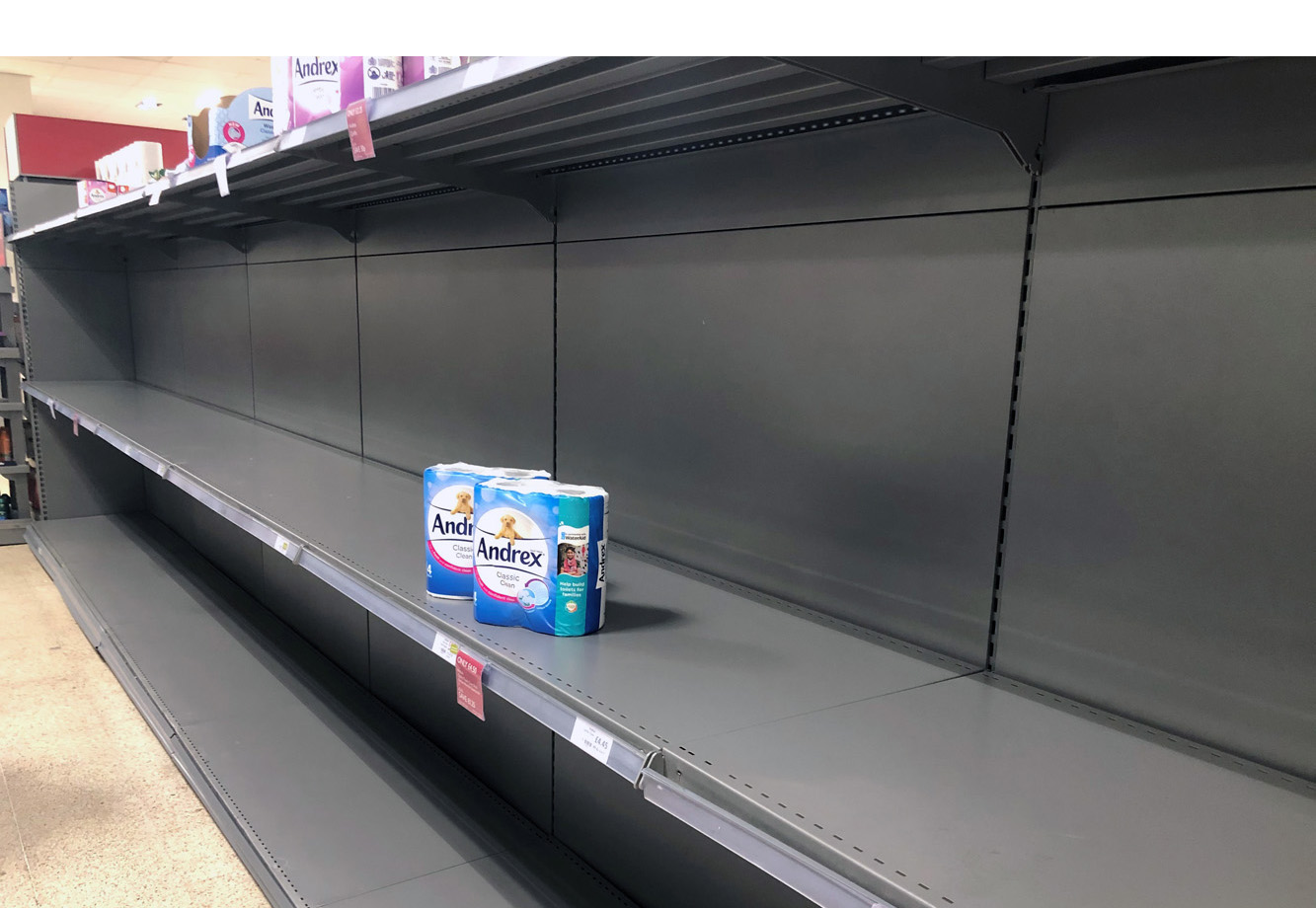 It then fell by a further 7.7% on 9 March – the biggest one-day fall since the 2008 financial crisis. This was specifically in response to a plunge in oil prices as Russia and Saudi Arabia engaged in a price war. But it also reflected growing pessimism about the economic impact of the coronavirus as the global spread of the epidemic accelerated and countries were contemplating more draconian lock-down measures.
It then fell by a further 7.7% on 9 March – the biggest one-day fall since the 2008 financial crisis. This was specifically in response to a plunge in oil prices as Russia and Saudi Arabia engaged in a price war. But it also reflected growing pessimism about the economic impact of the coronavirus as the global spread of the epidemic accelerated and countries were contemplating more draconian lock-down measures.
Firms have been drawing up contingency plans to respond to panic buying of essential items and falling demand for other goods. Supply-chain managers are working out how to respond to these changes and to disruptions to supplies from China and other affected countries.
Firms are also having to plan for disruptions to labour supply. Large numbers of employees may fall sick or be advised/required to stay at home. Or they may have to stay at home to look after children whose schools are closed.  For some firms, having their staff working from home will be easy; for others it will be impossible.
For some firms, having their staff working from home will be easy; for others it will be impossible.
Some industries will be particularly badly hit, such as airlines, cruise lines and travel companies. Budget airlines have cancelled several flights and travel companies are beginning to offer substantial discounts. Manufacturing firms which are dependent on supplies from affected countries have also been badly hit. This is reflected in their share prices, which have seen large falls.
Longer-term effects
Uncertainty could have longer-term impacts on aggregate supply if firms decide to put investment on hold. This would also impact on the capital goods industries which supply machinery and equipment to investing firms. For the UK, already having suffered from Brexit uncertainty, this further uncertainty could prove very damaging for economic growth.
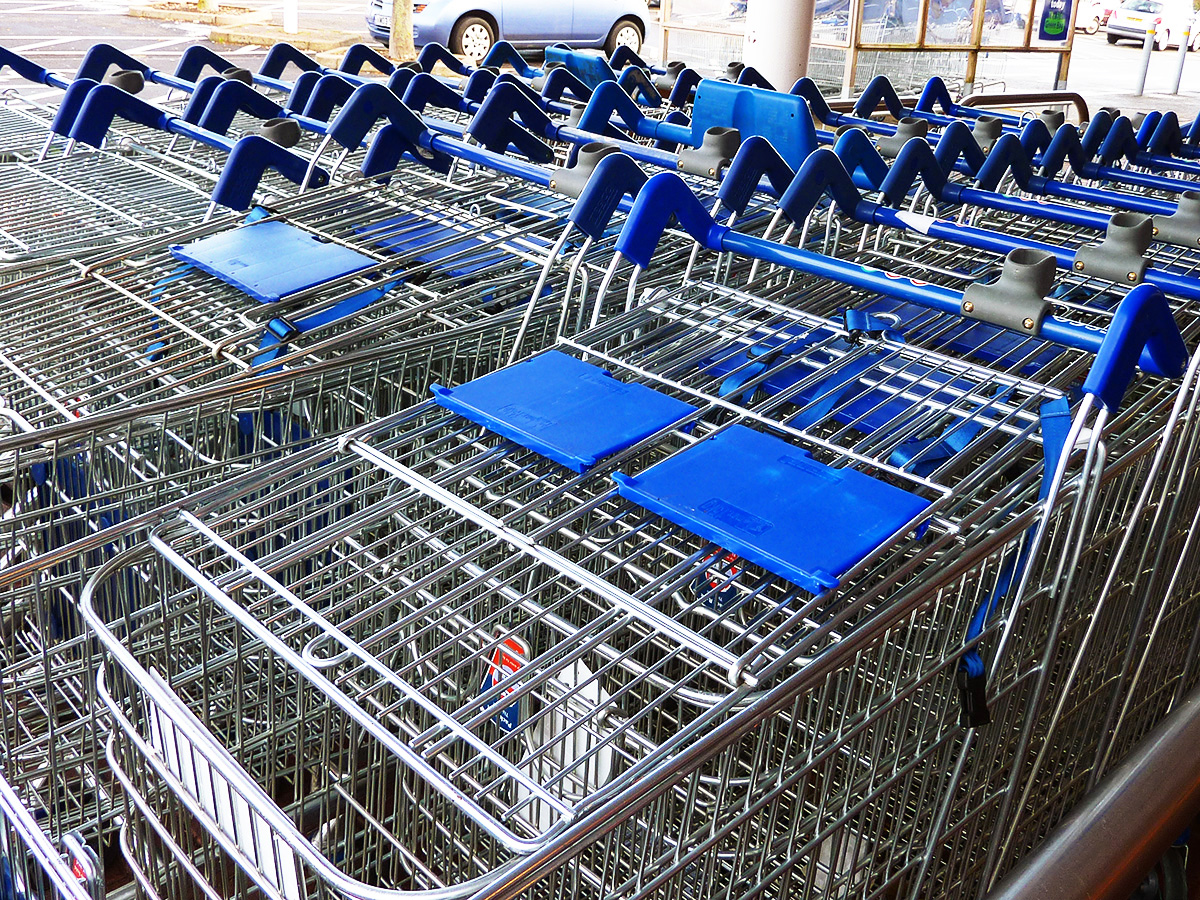 While aggregate supply is likely to fall, or at least to grow less quickly, what will happen to the balance of aggregate demand and supply is less clear. A temporary rise in demand, as people stock up, could see a surge in prices, unless supermarkets and other firms are keen to demonstrate that they are not profiting from the disease. In the longer term, if aggregate demand continues to grow at past rates, it will probably outstrip the growth in aggregate supply and result in rising inflation. If, however, demand is subdued, as uncertainty about their own economic situation leads people to cut back on spending, inflation and even the price level may fall.
While aggregate supply is likely to fall, or at least to grow less quickly, what will happen to the balance of aggregate demand and supply is less clear. A temporary rise in demand, as people stock up, could see a surge in prices, unless supermarkets and other firms are keen to demonstrate that they are not profiting from the disease. In the longer term, if aggregate demand continues to grow at past rates, it will probably outstrip the growth in aggregate supply and result in rising inflation. If, however, demand is subdued, as uncertainty about their own economic situation leads people to cut back on spending, inflation and even the price level may fall.
How quickly the global economy will ‘bounce back’ depends on how long the outbreak lasts and whether it becomes a serious pandemic and on how much investment has been affected. At the current time, it is impossible to predict with any accuracy the timing and scale of any such bounce back.
Articles
- Coronavirus: Global growth ‘could halve’ if outbreak intensifies
BBC News (2/3/20)
- Coronavirus: Eight charts on how it has shaken economies
BBC News, Lora Jones, David Brown & Daniele Palumbo (4/3/20)
- The economic ravages of coronavirus
BBC News, Douglas Fraser (7/3/20)
- What Coronavirus Could Mean for the Global Economy
Harvard Business Review, Philipp Carlsson-Szlezak, Martin Reeves and Paul Swartz (3/3/20)
- Coronavirus escalation could cut global economic growth in half – OECD
The Guardian, Richard Partington and Phillip Inman (2/3/20)
- U.S. Fed Cuts Rates, There Are Still Strategies The ECB Can Follow
Forbes, Stephen Pope (3/3/20)
- A coronavirus recession could be supply-side with a 1970s flavour
The Guardian, Kenneth Rogoff (3/3/20)
- Coronavirus will wreak havoc on the US economy
CNN, Mark Zandi (3/3/20)
- UK factories feel the effects of coronavirus spread – PMI
Reuters, William Schomberg (2/3/20)
- The first economic modelling of coronavirus scenarios is grim for Australia, the world
The Conversation, Australia, Warwick McKibbin and Roshen Fernando (3/3/20)
- Extraordinary complacency: the coronavirus and emerging markets
Financial Times, Geoff Dennis (2/3/20)
- Coronavirus Economic Impact On Global Economy
Seeking Alpha, Mark Bern (1/3/20)
- OECD warns coronavirus could halve global growth
Financial Times, Chris Giles, Martin Arnold and Brendan Greeley (2/3/20)
- BoE’s Carney sees ‘powerful and timely’ global response to coronavirus
Reuters, David Milliken, Elizabeth Howcroft (3/3/20)
eBook
Questions
- Using a supply and demand diagram, illustrate the fall in stock market prices caused by concerns over the effects of the coronavirus.
- Using either (i) an aggregate demand and supply diagram or (ii) a DAD/DAS diagram, illustrate how a fall in aggregate supply as a result of the economic effects of the coronavirus would lead to (a) a fall in real income and (i) a fall in the price level or (ii) a fall in inflation; (b) a fall in real income and (i) a rise in the price level or (ii) a rise in inflation.
- What would be the likely effects of central banks (a) cutting interest rates; (b) engaging in further quantitative easing?
- What would be the likely effects of governments running a larger budget deficit as a means of boosting the economy?
- Distinguish between stabilising and destabilising speculation. How would you characterise the speculation that has taken place on stock markets in response to the coronavirus?
- What are the implications of people being paid on zero-hour contracts of the government requiring workplaces to close?
- What long-term changes to working practices and government policy could result from short-term adjustments to the epidemic?
- Is the long-term macroeconomic impact of the coronavirus likely to be zero, as economies bounce back? Explain.
 In its latest Commodity Special Feature (pages 43 to 53 of the October 2020 World Economic Outlook), the IMF examines the future of oil and other commodity prices. With the collapse in oil demand during the early stages of the coronavirus pandemic, oil prices plummeted. Brent crude fell from around $60 per barrel in late January to below $20 in April.
In its latest Commodity Special Feature (pages 43 to 53 of the October 2020 World Economic Outlook), the IMF examines the future of oil and other commodity prices. With the collapse in oil demand during the early stages of the coronavirus pandemic, oil prices plummeted. Brent crude fell from around $60 per barrel in late January to below $20 in April.  The IMF considers the future for oil prices and concludes that prices will remain subdued. It forecasts that petroleum spot prices will average $47 per barrel in 2021, up only slightly from the $42 average it predicts for 2020.
The IMF considers the future for oil prices and concludes that prices will remain subdued. It forecasts that petroleum spot prices will average $47 per barrel in 2021, up only slightly from the $42 average it predicts for 2020. For the majority of people, a house (or flat) is the most valuable thing they will ever own.
For the majority of people, a house (or flat) is the most valuable thing they will ever own. Changes in the housing market are always given such importance due to the relationship house prices have with consumer spending. Changes in house prices and the number of sales affect how much money people have to spend. Given that household spending accounts for two-thirds of Britain’s total economic activity, any changes in consumption is likely to have a major impact on the wider economy. Observing the housing market helps us to assess the overall demand for goods and services.
Changes in the housing market are always given such importance due to the relationship house prices have with consumer spending. Changes in house prices and the number of sales affect how much money people have to spend. Given that household spending accounts for two-thirds of Britain’s total economic activity, any changes in consumption is likely to have a major impact on the wider economy. Observing the housing market helps us to assess the overall demand for goods and services. The first is when a new build is purchased. This directly contributes to GDP through the investment in the land to build the house on, the purchase of materials and the creation of jobs. Once the homeowners move in they also contribute to the local economy: i.e. shopping at local shops.
The first is when a new build is purchased. This directly contributes to GDP through the investment in the land to build the house on, the purchase of materials and the creation of jobs. Once the homeowners move in they also contribute to the local economy: i.e. shopping at local shops.  The supply of new housing in the short run is price inelastic. The main reason for this is the time it takes to build a new home. The production of a house can take many months, from the planning process to the project’s completion. Supply also relies on access to a skilled labour force and the availability of certain construction materials.
The supply of new housing in the short run is price inelastic. The main reason for this is the time it takes to build a new home. The production of a house can take many months, from the planning process to the project’s completion. Supply also relies on access to a skilled labour force and the availability of certain construction materials.  London estate agency, Hamptons, states that homeowners are now bringing forward their moving plans as the experience of lockdown has encouraged them to seek more space. The mortgage market is also very favourable right now in terms of interest rates, and rental demand is continuing to surge across the UK.
London estate agency, Hamptons, states that homeowners are now bringing forward their moving plans as the experience of lockdown has encouraged them to seek more space. The mortgage market is also very favourable right now in terms of interest rates, and rental demand is continuing to surge across the UK.  Share prices are determined by demand and supply. The same applies to stock market indices, such as the
Share prices are determined by demand and supply. The same applies to stock market indices, such as the  The first chart shows how the FTSE 100 fell from 7466 in early February 2020 to 5190 in late March, a fall of 30.5%. The Dow Jones fell by 34% over the same period. In both cases the fall was driven not only by the decline in the respective economy over the period, but by speculation that further declines were to come (click
The first chart shows how the FTSE 100 fell from 7466 in early February 2020 to 5190 in late March, a fall of 30.5%. The Dow Jones fell by 34% over the same period. In both cases the fall was driven not only by the decline in the respective economy over the period, but by speculation that further declines were to come (click  This involves central banks buying government bonds and possibly corporate bonds too with newly created money. The extra money is then used to purchase other assets, such as stocks and shares and property, or physical capital or goods and services. The second chart shows that quantitative easing by the Bank of England increased the Bank’s asset holding from April to July 2020 by 50%, from £469bn to £705bn (click
This involves central banks buying government bonds and possibly corporate bonds too with newly created money. The extra money is then used to purchase other assets, such as stocks and shares and property, or physical capital or goods and services. The second chart shows that quantitative easing by the Bank of England increased the Bank’s asset holding from April to July 2020 by 50%, from £469bn to £705bn (click  As infection and death rates from Covid-19 waned around Europe and in many other countries, so consumer and business confidence rose. This is illustrated in the third chart, which shows industrial, consumer and construction confidence indicators in the EU. As you can see, after falling sharply as the pandemic took hold in early 2020 and countries were locked down, confidence then rose (click
As infection and death rates from Covid-19 waned around Europe and in many other countries, so consumer and business confidence rose. This is illustrated in the third chart, which shows industrial, consumer and construction confidence indicators in the EU. As you can see, after falling sharply as the pandemic took hold in early 2020 and countries were locked down, confidence then rose (click  A final, but related, cause of recent stock market movements is speculation. If people see share prices falling and believe that they are likely to fall further, then they will sell shares and hold cash or safer assets instead. This will amplify the fall and encourage further speculation. If, however, they see share prices rising and believe that they will continue to do so, they are likely to want to buy shares, hoping to make a gain by buying them relatively cheaply. This will amplify the rise and, again, encourage further speculation.
A final, but related, cause of recent stock market movements is speculation. If people see share prices falling and believe that they are likely to fall further, then they will sell shares and hold cash or safer assets instead. This will amplify the fall and encourage further speculation. If, however, they see share prices rising and believe that they will continue to do so, they are likely to want to buy shares, hoping to make a gain by buying them relatively cheaply. This will amplify the rise and, again, encourage further speculation. With promises by the newly elected Conservative government to increase investment expenditure on health, education, innovation and infrastructure, it was expected that Rishi Sunak’s first Budget would be strongly expansionary. In fact, it turned out to be two Budgets in one – both giving a massive fiscal boost.
With promises by the newly elected Conservative government to increase investment expenditure on health, education, innovation and infrastructure, it was expected that Rishi Sunak’s first Budget would be strongly expansionary. In fact, it turned out to be two Budgets in one – both giving a massive fiscal boost. This emergency part of the Budget was co-ordinated with the Bank of England’s decision to cut Bank Rate from 0.75% to 0.25%.
This emergency part of the Budget was co-ordinated with the Bank of England’s decision to cut Bank Rate from 0.75% to 0.25%.  The second part of the Budget is to raise government investment by 9% in real terms over the next four years, bringing overall government expenditure to 41% of GDP, financed largely by extra borrowing. As the IFS observes, “That is above its pre-crisis level and bigger than at any point between the mid 1980s and the start of the financial crisis.”
The second part of the Budget is to raise government investment by 9% in real terms over the next four years, bringing overall government expenditure to 41% of GDP, financed largely by extra borrowing. As the IFS observes, “That is above its pre-crisis level and bigger than at any point between the mid 1980s and the start of the financial crisis.”
 The global economic impact of the coronavirus outbreak is uncertain but potentially very large. There has already been a massive effect on China, with large parts of the Chinese economy shut down. As the disease spreads to other countries, they too will experience supply shocks as schools and workplaces close down and travel restrictions are imposed. This has already happened in South Korea, Japan and Italy. The size of these effects is still unknown and will depend on the effectiveness of the containment measures that countries are putting in place and on the behaviour of people in self isolating if they have any symptoms or even possible exposure.
The global economic impact of the coronavirus outbreak is uncertain but potentially very large. There has already been a massive effect on China, with large parts of the Chinese economy shut down. As the disease spreads to other countries, they too will experience supply shocks as schools and workplaces close down and travel restrictions are imposed. This has already happened in South Korea, Japan and Italy. The size of these effects is still unknown and will depend on the effectiveness of the containment measures that countries are putting in place and on the behaviour of people in self isolating if they have any symptoms or even possible exposure. It then fell by a further 7.7% on 9 March – the biggest one-day fall since the 2008 financial crisis. This was specifically in response to a plunge in oil prices as Russia and Saudi Arabia
It then fell by a further 7.7% on 9 March – the biggest one-day fall since the 2008 financial crisis. This was specifically in response to a plunge in oil prices as Russia and Saudi Arabia  For some firms, having their staff working from home will be easy; for others it will be impossible.
For some firms, having their staff working from home will be easy; for others it will be impossible. While aggregate supply is likely to fall, or at least to grow less quickly, what will happen to the balance of aggregate demand and supply is less clear. A temporary rise in demand, as people stock up, could see a surge in prices, unless supermarkets and other firms are keen to demonstrate that they are not profiting from the disease. In the longer term, if aggregate demand continues to grow at past rates, it will probably outstrip the growth in aggregate supply and result in rising inflation. If, however, demand is subdued, as uncertainty about their own economic situation leads people to cut back on spending, inflation and even the price level may fall.
While aggregate supply is likely to fall, or at least to grow less quickly, what will happen to the balance of aggregate demand and supply is less clear. A temporary rise in demand, as people stock up, could see a surge in prices, unless supermarkets and other firms are keen to demonstrate that they are not profiting from the disease. In the longer term, if aggregate demand continues to grow at past rates, it will probably outstrip the growth in aggregate supply and result in rising inflation. If, however, demand is subdued, as uncertainty about their own economic situation leads people to cut back on spending, inflation and even the price level may fall.